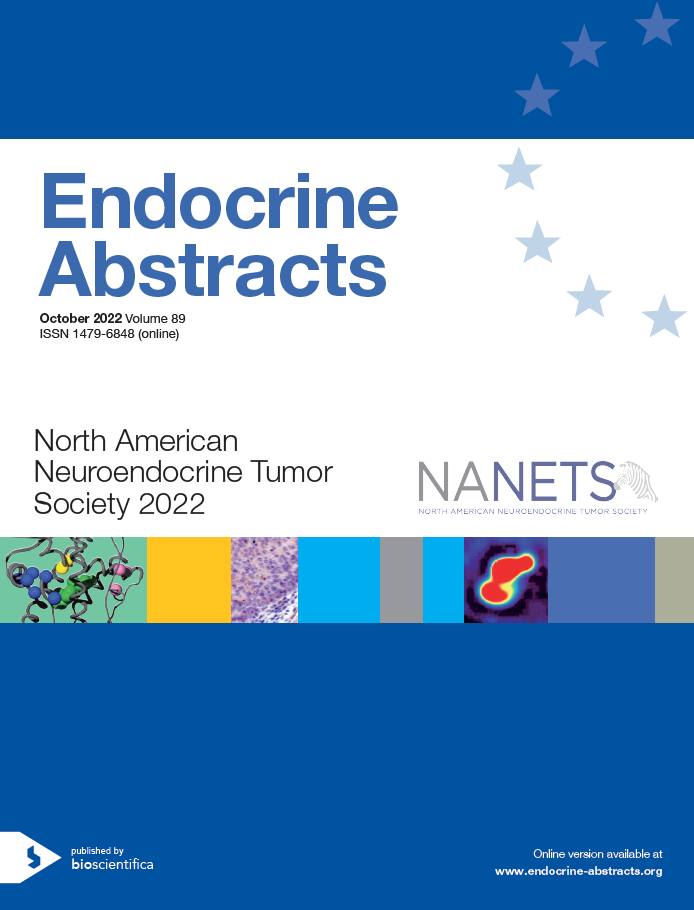15th Annual Multidisciplinary NET Medical Symposium NANETS 2022
Clinical – Chemo/SSA/Biologics
ea0089c1 | Clinical – Chemo/SSA/Biologics | NANETS2022
Progression-Free Survival in Patients with Bronchopulmonary Neuroendocrine Tumors Treated with Lanreotide or Placebo: Adjustment for Crossover Effects in Placebo Arm
Singh Simron , Buikhuisen Wieneke , Capdevila Jaume , Caplin Martyn E , Grohe Christian , Horsch Dieter , Raderer Markus , Reidy-Lagunes Diane , Wolin Edward M , Pommie Christelle , Mai Truong Xuan , Baudin Eric
ea0089c2 | Clinical – Chemo/SSA/Biologics | NANETS2022
Pembrolizumab for the Treatment of Recurrent High Grade Neuroendocrine Neoplasms
Hunter, MD Lindsay A , Whisenant, MD Jonathan , Weldon Gilcrease, MD G.
ea0089c3 | Clinical – Chemo/SSA/Biologics | NANETS2022
Real World Analysis of Long-Acting Somatostatin Analog (LA-SSA) Treatment and Dose Escalation Among Patients with Neuroendocrine Tumors (NET)
Clarke, MD, MS Callisia N. , Cockrum, BSci, PharmD, RPh Paul , Beveridge, MSc, PhD Thomas J.R. , Jerry, MS Michelle , McMorrow, BS Donna , Thu Tran, PharmD Anh , Phan, MD Alexandria T.
ea0089c4 | Clinical – Chemo/SSA/Biologics | NANETS2022
Cisplatin vs Carboplatin in Extrapulmonary Poorly Differentiated Neuroendocrine Carcinomas (PD NEC)
McLaughlin Nicole , McGarrah Patrick , Eiring Rachel , Leventakos Konstantinos , Sonbol Mohamad , Starr Jason , Hobday Timothy , Halfdanarson Thorvardur
ea0089c5 | Clinical – Chemo/SSA/Biologics | NANETS2022
c-MET Expression in MEN1-associated Neuroendocrine Tumors
MD Raisa Ghosh , BS Maya Lee , BS Rana Tora , MGC, CGC James Welch , I Vaishali , BS Parekh , MD Jaydira del Rivero , F William , MD Simonds , MD Lee Scott Weinstein , E Jenny , MD Blau , K Sunita , Ph.D Agarwal , MD Smita Jha
ea0089c6 | Clinical – Chemo/SSA/Biologics | NANETS2022
An Open-Label, Phase 1b/2 study of Surufatinib in Combination with Tislelizumab in Patients with Advanced Neuroendocrine Tumors
Eads, MD Jennifer R. , Das, MD Satya , Li, MD Daneng , Mohamed, MD Amr , Tucci, MBS, CCRP Christopher , Nanda, MS Shivani , Kauh, MD, FACP John S. , Kania, MD, MBA Marek K. , Dasari, MD Arvind
ea0089c7 | Clinical – Chemo/SSA/Biologics | NANETS2022
Risk of Myelodysplastic Syndrome/Acute Leukemia with Sequential Capecitabine/Temozolomide and 177Lu-Dotatate
MPH Taymeyah Al-Toubah , MD Eleonora Pelle , MD Jonathan Strosberg
ea0089c8 | Clinical – Chemo/SSA/Biologics | NANETS2022
Phase II Study of Pembrolizumab and Lenvatinib in Advanced Well-Differentiated Neuroendocrine Tumors
Al-Toubah, MPH Taymeyah , Morse, MD Brian , Haider, MD Mintallah , Valone, PA Tiffany , Strosberg, MD Jonathan
ea0089c9 | Clinical – Chemo/SSA/Biologics | NANETS2022
Correlation of MEN1 and DAXX Mutational Status with Response to Capecitabine and Temozolomide (CAPTEM) in Pancreatic Neuroendocrine Tumors
Lee Patrick C , Blais Edik M , Gong Jun , Osipov Arsen , Moshayedi Natalie , Thomassian Shant , Ng Camille , Chuy Jennifer , Matrisian Lynn M , Petricoin III Emanuel F , Pishvaian Michael J , Hendifar Andrew E
ea0089c10 | Clinical – Chemo/SSA/Biologics | NANETS2022
ACTH-secreting Pancreatic Neuroendocrine Neoplasms: A Case-Series
Pelle, MD Eleonora , Al-Toubah, MPH Taymeyah , Hallanger-Johnson, MD Julie , Strosberg, MD Jonathan
ea0089c11 | Clinical – Chemo/SSA/Biologics | NANETS2022
Results from the Phase 1, Randomized, Open-Label, Cross-Over Study to Evaluate Pharmacokinetics of Three Escalating Doses of Oral Octreotide Capsules
Fuchs Orenbach Shir , Haviv Asi
ea0089c12 | Clinical – Chemo/SSA/Biologics | NANETS2022
Financial Toxicity and Supportive Care in Neuroendocrine Tumor: A Biobank Study
Mariam Roy Arya , Kaur Jasmine , Attwood Kristopher , Iyer Renuka
ea0089c13 | Clinical – Chemo/SSA/Biologics | NANETS2022
Serum Serotonin Compared to Plasma 5-HIAA and Chromogranin A as Biomarkers of Response to Hepatic Artery Bland Embolization
Blanford Cole , Yan Donglin , Li Ning , Woodworth Alison , Gabriel Gaby , Khouli Riham El , Chauhan Aman , Anthony Lowell




